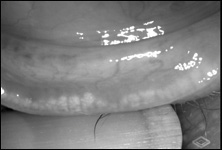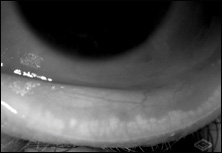Use integrative approach to stress-induced dry eye
Click Here to Manage Email Alerts
Dry eye is one of the most frequently encountered ophthalmic conditions, with prevalence as high as 87.5% (Fenga et al.) among computer users and 73.5% (Uchini et al.) among the elderly population.
Symptoms include fluctuating vision, tired eyes, redness, burning, foreign body sensation, excessive tearing, itching and recurring eye infections. Causes include age, menopause, allergies, medication (antihistamines, diuretics, antidepressants, birth control pills, beta-blockers and hormone replacement therapy), low humidity environments, lid disease and contact lens wear.
I believe there is another important, yet overlooked, cause for dry eye: stress, both psychological and visual. Over the years, I have seen an overwhelmingly high percentage of my dry eye patients report a high level of stress – psychological (such as depression, stress from work or family) or visual stress from excessive use of digital devices. Patients with blepharitis, meibomian gland dysfunction (MGD), hordeolum and chalazia are usually also stressed.

Contributors to stress
Stress is becoming a public health crisis, according to the American Psychological Association. Most Americans are reporting more stress, depression and anxiety due to the economy, environment and job instability. Children also show signs of stress because their parents are stressed. Physical symptoms include difficulty sleeping, headaches, stomachaches and weight gain. Stress is being associated with more health problems, such as hypertension, obesity, diabetes, depression and gastrointestinal problems.
In addition to chronic stress, modern-day technology has turned us into a visual work force instead of a physical work force. Computers, cell phones and tablets are an integral part of our daily life; however, their excessive use creates a heavy visual demand, making people more vulnerable to dry eye at a younger age. The use of digital devices is typically associated with partial or infrequent blinking, which prevents the spreading of tear film evenly over the ocular surface. This causes stasis of meibomian gland secretions, resulting in blockage of the glands, inflammation and eventually atrophy.
Weakening of the immune system as a result of stress also contributes to dry eye. Overgrowth of common commensals of eyelid margins (eg, Staphylococcus aureus, coagulase-negative staphylococci and Propionibacterium acnes) have also been implicated in the pathogenesis of MGD. When questioning my patients with dry eye disease (DED), as well as other lid conditions such as blepharitis, MGD and hordeolum, I have found that the majority live demanding, chronically high-stress lives or had a recent increase in work load or psychological stress.
Management strategies
Management strategies for dry eye include a wide variety of pharmacologic and nonpharmacologic approaches such as lubricants, nutritional supplements, antibiotics, anti-inflammatory drugs and punctum plugs. With the recognition of MGD as the most common cause of DED, it is evident that using lubricants and treating lid margin inflammation is not sufficient.
For MGD-associated dry eye, it is critical to relieve meibomian gland obstruction through warm compresses and lid hygiene. It is difficult to reach the critical melting point and maintain it long enough to liquefy the clogged meibomian glands. This problem is solved with infrared heated eye masks that also increase circulation to promote healing. The MiBo Heating Pad by the MiBo Medical Group (Dallas) and the Moisture Eyes Heavenly Heat Pad developed by the Heat Pad Company (Gilroy, Calif.) stay heated to 108°F via a USB cord.
Lid hygiene is more effective when combined with an eyelid cleanser such as ZocuFoam (Zocular), Avenova (NovaBay) or Ocusoft Lid Scrub. Topical steroids and oral antibiotics such as doxycycline are effective treatment options due to their anti-inflammatory properties, but if used on a long-term basis they have potential side effects, including glaucoma, cataracts, antibiotic resistance and gastrointestinal discomfort.
A more natural approach is ZocuFoam cleanser and moisturizer. It uses the proprietary Zokrex made from the okra plant to reduce inflammation and remove bacteria, Demodex and debris while moisturizing the eyelids with aloe.
For in-office dry eye therapy there are several excellent options that radiate heat while massaging the meibomian glands to liquefy and evacuate thickened meibum. The MiBo ThermoFlo (Mibo Medical Group) massages the eyelids with a platinum probe heated to 108°F (42.2°C). Pretreatment, I use povidone-iodine to disinfect the ocular surface and treat blepharitis. I also use LidPro (Mibo Medical Group) to exfoliate the eyelid margins to treat anterior blepharitis.




The Lipiflow Activator by TearScience (Morrisville, N.C.) is another device that effectively treats MGD by using heat and pressure on the meibomian glands at 109°F. Therapeutic motion from the patented heat and adaptive force equalization provides proximal to distal peristalsis to clear the gland contents of stagnant meibum and bacteria.
When appropriate, I prescribe anti-inflammatory agents (cyclosporine, lifitegrast, etc.) and antibiotics (azithromycin and tetracycline derivatives). Heated treatment further improves the signs and symptoms of dry eye by opening up inspissated meibomian glands, which harbor bacteria and lead to a vicious cycle that perpetuates and worsens dry eye disease.
Prescribing nutraceuticals
To improve tear quality and quantity, I prescribe HydroEye, an omega fatty acid supplement by ScienceBased Health (Houston) that was found to relieve dry eye signs and symptoms in a clinical trial. HydroEye includes GLA – a unique anti-inflammatory omega (not found in fish or our diet) that has been proven in seven dry eye clinical trials (Sheppard et al.). Together, GLA and other nutrients work together to support all three layers of the tear film. HydroEye uses a unique gamma-linoleic acid (GLA) that is not found in fish or flaxseed oil, which eliminates the fishy taste. HydroEye also contains a blend of other omega fatty acids and nutrient cofactors to decrease tear gland inflammation.
I prescribe Ultra Dry Eye TG (OcuSci Inc., Del Mar, Calif.) for my patients older than 40 years old because it has lutein and zeaxanthin and vitamins D3 and B12, which are valuable for ocular nutritional support as we age. The product uses a superior absorbing triglyceride molecular form of omega-3 from Alaskan wild-caught pollock. Most American diets are deficient in these key nutrients that support overall vision health.
The third part of my dry eye treatment includes prescribing homeopathic drops instead of artificial tears. Natural Ophthalmics (Dillon, Colo.) has two unique formulas: one with ingredients indicated for women with dryness related to hormone fluctuation and the other indicated for evaporative dry eye.
Natural Ophthalmics will be soon releasing a new formula for treating blepharitis and MGD that includes ingredients for underlying stress. This formula will also target other issues associated with dry eyes including immune support, allergies and eyelid hypertrophy.
Patient education is invaluable for compliance because seeing is believing. MiBoCam (Mibo Medical Group) and Meibox (Box Medical Solutions, West Hills, Calif.) take infrared images of the meibomian glands to demonstrate to patients anatomical changes that are associated with their symptoms, such as truncation from atrophy.
Addressing stress
The fourth, and critical, step is to address underlying stress. This prevents the dry eye that results from the cycle of a stress-weakened immune system. I educate patients about the health risks of long-term stress, including hypertension, heart disease, stroke, gastrointestinal problems, depression, obesity and lid disease. Stress management counseling and referrals help our patients stay healthy and incorporate medication, yoga, exercise, healthy diet, acupuncture and healthy sleep.
Overall, an integrative approach to dry eye treatment addresses the underlying cause of stress-induced dry eyes. Clearing the obstruction, improving tear quality, curbing inflammation, stimulating tear production and showing the patient the damage caused by MGD are all essential to treating dry eyes. Addressing the underlying stress that can lead to inflammation and dry eyes is a critical step that needs to be part of your treatment to prevent chronic dry eye.
- References:
- American Psychological Association. Stressed in America. Monitor on Psychology. 2011;42(1):60-61.
- Bernstein AM, et al. J Clin Lipidol. 2014;doi:10.1016/j.jacl.2014.08.001.
- de Sousa Ferreira Soares G, et al. Protein J. 2012;doi:10.1007/s10930-012-9447-0.
- Fenga C, et al. Am J Ophthalmol. 2014;doi.org/10.1016/j.ajo.2014.03.007.
- Gopinath B, et al. Am J Clin Nutr. 2013;doi.org/10.3945/ajcn.112.057091.
- Huang J, et al. Chinese Journal of PracticalOphthalmology. 2012:30(5).
- Kiecolt-Glaser JK, et al. J Consult Clin Psychol. 2002;70(3):537.
- Miki U, et al. Optom Vis Sci. 2006;doi:10.1097/01.opx.0000232814.39651.
- Millen AE, et al. Arch Ophthalmol. 2011;doi:10.1001/archophthalmol.2011.48.
- Moeller SM, et al. Arch Ophthalmol. 2008;doi:10.1001/archopht.126.3.354.
- Nesa L, et al. Br J Pharm Res. 2014;4(7):849–860.
- Segerstrom SC, et al. Psychol Bull. 2004;doi:10.1037/0033-2909.130.4.601.
- For more information:
- Elise Brisco, OD, FAAO, FCOVD, CCH, is in a multidisciplinary integrative group practice. She cofounded a rehabilitative vision clinic at the Cedars Sinai Medical Center, which is now at the California Rehabilitation Institute. She is a Certified Clinical Homeopath. Brisco can be reached at https://www.hollywoodvision.com/.
Disclosure: Brisco is the chief medical advisor for Natural Ophthalmics.
